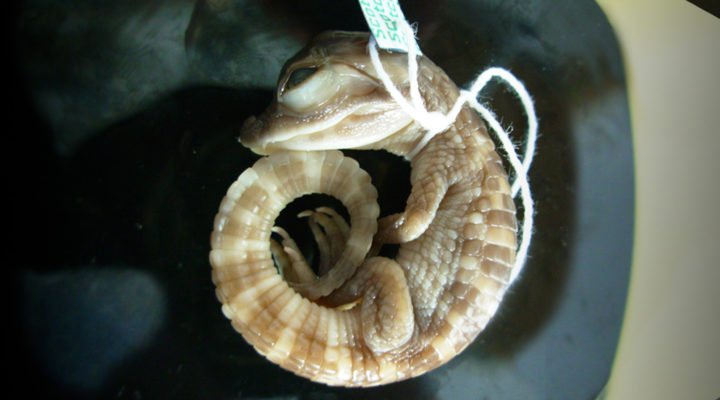Exact and Natural Sciences
New study on the development of caimans in Argentina
CONICET scholar described how the cartilaginous skulls of those reptiles have evolved during their embryonic stage.
In biology, ontogeny refers to the road map an organism follows over its different life stages. The ontogenetic studies are a fundamental tool for other disciplines such as paleontology because those analysis provide valuable information: based on the knowledge of the development of the skeleton of current species it is possible to make inferences about fossils related to those species, thus contributing with the evolutionary history of the different groups. This is the study conducted by CONICET scholar María Victoria Fernandez Blanco. She has recently published an article in the Journal of Anatomy where she describes the way in which the skull of two caiman species that live currently in Argentina start and modify during the embryonic stage.
The study shows part of the results obtained by Fernandez Blanco as part of her doctoral thesis. She made morphological analysis of the skeleton of two representatives of aligatoridae –one of the three great groups in which the different species of crocodiles are divided into- present in Argentina: Caiman yacare and Caiman latirostri. In this particular publication, the expert focused on the evolution of chondrocranium or cartilaginous skull, that is to say the first structure that covers the brain and the sense organs of these caimans with was later replaced by bones.
“There are two species widely distributed in South America. They are in Brazil, Uruguay, Bolivia and Argentina, particularly in the provinces of Chaco, Corrientes, Entre Ríos, Formosa, Misiones, Salta and Santa Fe”, the researcher states. She works at the Faculty of Natural Sciences and the Museum of the National University of La Plata (FCNyM, UNLP). This study the scientist conducted focused on the earliest stages of development, the analysis of the head in its cartilaginous state and the description of what happens in each embryonic stage comparing both species among themselves and with others.
To undertake her work, Fernandez Blanco collected caiman eggs in three different research campaigns to the province of Chaco in 2012, 2015 and 2018. “The first difficult part is to calculate the time of development of each egg. As some reference, it was useful to have the study of one Argentine researcher Josefina Iungman, who established embryonic stages in C. latirostris using its external morphology. Besides, it was fundamental the contribution of the locals who let me know when the females laid eggs. The manipulation of the eggs demand specific care as they have to remain in the same position they were in the nestle during the move and in the incubation process. The objective is not to alter the air chamber that is inside and avoid the death of the embryo. As we want to make the least possible impact on the populations of these animals, a limited amount of samples of each species was taken”, the scientist explained.
The collection of eggs was done in the rural area and wildlife refuge “Estancia El Cachapé”, near the city of Resistencia where a caiman farm used to be located. “First we put each specimen in formalin. Then we use a technique that makes soft tissue transparent. That allows us to observe the details of the bones and cartilage, that is to say, where they are, in which stage and how each of elements are formed”, the researcher describes.
Through daily monitoring, Fernandez Blanco managed to establish a sequence of development of the elements of the skull, which represents the first study on its type about caimans. “There are some old embryonic studies on crocodiles, but on these species of present caimans in Argentina”, she comments.
The expert concludes: “These descriptive work on basic anatomy are useful in several aspects. It is important to know what happens in pre-hatching stages because, for instance, maybe what is observed in one adult as a unique bone can be formed originally by two that fused together. Knowing these details is really valuable.”
By Marcelo Gisande.
About the study:
María Victoria Fernandez Blanco. Postdoctoral scholar. FCNyM, UNLP.
